When it comes to recognizing bugs in your aquarium, it’s important to know a few common tiny creatures. These include Copepods, Water Fleas, Seed Shrimp, Freshwater Limpet, Tubifex, Nematodes, Planaria, Hydra, Bryozoa, Springtails, Mosquito larvae, and Bloodworms. Each of these creatures have unique characteristics that distinguish them from one another.
I’ve spent countless hours watching the fascinating world inside my tank and outside in streams bug hunting, It’s not just about the fish and shrimp there’s a whole ecosystem of tiny creatures that often go unnoticed. From the dancing Copepods to the round Seed Shrimp and the regenerating Planaria, each one has its own unique part to play in keeping the tank environment healthy. In this guide, I’ll be sharing with you how to recognize these common aquarium bugs and understand their roles in the aquatic world. Let’s dive in!
Your Aquarium’s Ecosystem
The aquarium is a miniature world, teeming with life that extends beyond the colorful fish we typically associate with these habitats. If you look closer, you’ll discover an ecosystem bustling with tiny creatures, often overlooked but playing crucial roles in maintaining the balance of this aquatic life.
These small organisms, known as aquarium bugs, are diverse and include species like copepods, water fleas, seed shrimp, and many others. While some of these creatures float freely in the water, others cling to the glass walls or burrow into the substrate. They contribute to the ecosystem by breaking down waste materials, serving as a food source for other organisms, and even helping to control the growth of certain harmful species.
Understanding these tiny creatures and their roles can deepen your appreciation for your aquarium. It can also help you maintain a healthier and more balanced tank. A sudden increase in the population of a particular organism or the appearance of a new one can serve as an indicator of changes in the tank environment.
In the following sections, we’ll explore some of the most common bugs you might encounter in your aquarium. We’ll discuss their characteristics, their behaviors, and the roles they play in your tank’s ecosystem. By the end of this guide, you’ll be equipped with the knowledge to identify these fascinating organisms and understand their place in your aquarium.
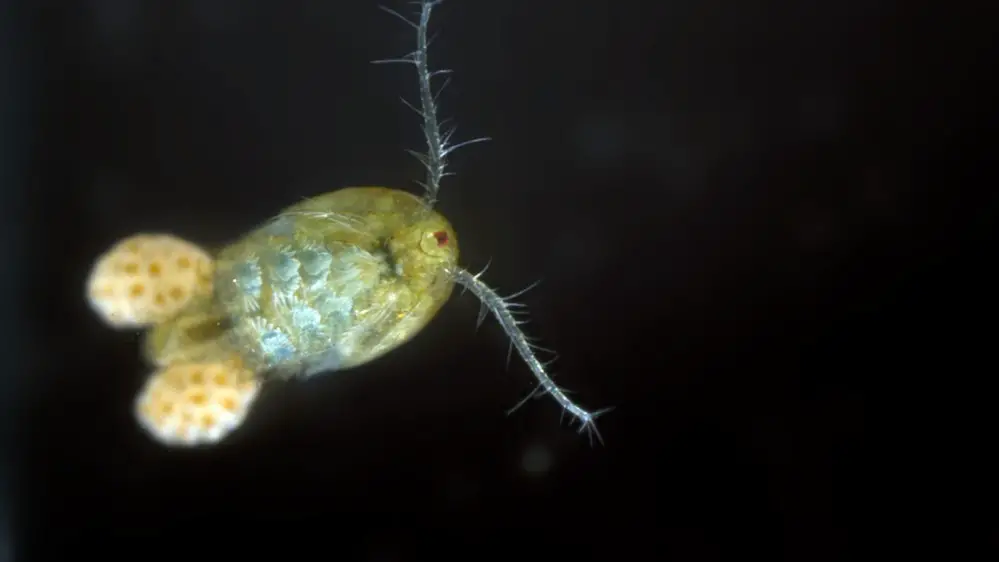
Copepods: The One-Eyed Crustaceans
Copepods are fascinating, tiny creatures that inhabit the world of our aquariums. They’re small crustaceans, typically measuring between 0.1 to 0.2 cm or 0.04 to 0.1 inches in size. What sets copepods apart is their singular eye, which gives them a unique and somewhat amusing appearance.
These creatures are known for their distinctive style of movement. They don’t swim around your tank in the way that fish do. Instead, they move by making short leaps, traveling across surfaces such as the tank glass and other objects. If you watch them closely, you might even notice different colored species, adding another layer of diversity to your aquatic ecosystem.
Copepods play a crucial role in your tank’s health. They feed on various organic materials, helping to clean the tank and maintain water quality. They’re also an essential part of the food chain, providing a valuable food source for smaller fish and other aquatic animals.
Despite their size, copepods are harmless creatures. They add variety to your tank’s ecosystem without posing any risk to the other inhabitants. Their cute appearance and unique behaviors can add an extra layer of interest to your aquarium, making them a welcome addition to many tanks.

Water Fleas Daphnia: The Aquarium’s Reindeers
Water Fleas, scientifically known as Daphnia, are another group of fascinating tiny creatures that you might find in your aquarium. They’re small crustaceans, typically measuring between 0.1 to 0.5 cm or 0.04 to 0.2 inches in size. Their name comes from their unique, jerky movement, which can appear as though they’re bouncing or hopping in the water – much like a flea.
These creatures have a distinctive look. Their transparent bodies and the way they move in the water have earned them a quirky nickname: the aquarium’s reindeers. This name is a testament to their unique appearance and behavior, which can add a touch of charm to your aquatic environment.
Water fleas play a key role in the food chain of your aquarium ecosystem. They are commonly used as a live food source for fish, providing essential nutrients and aiding in their growth and development. At the same time, water fleas help maintain the cleanliness of your tank by consuming organic matter.
Water fleas are harmless and interesting creatures. They have a unique role in the ecosystem of your aquarium, contributing to its health while providing a captivating spectacle. Their intriguing behaviors, combined with their importance to the food chain, make them a beneficial and charming addition to your aquarium.
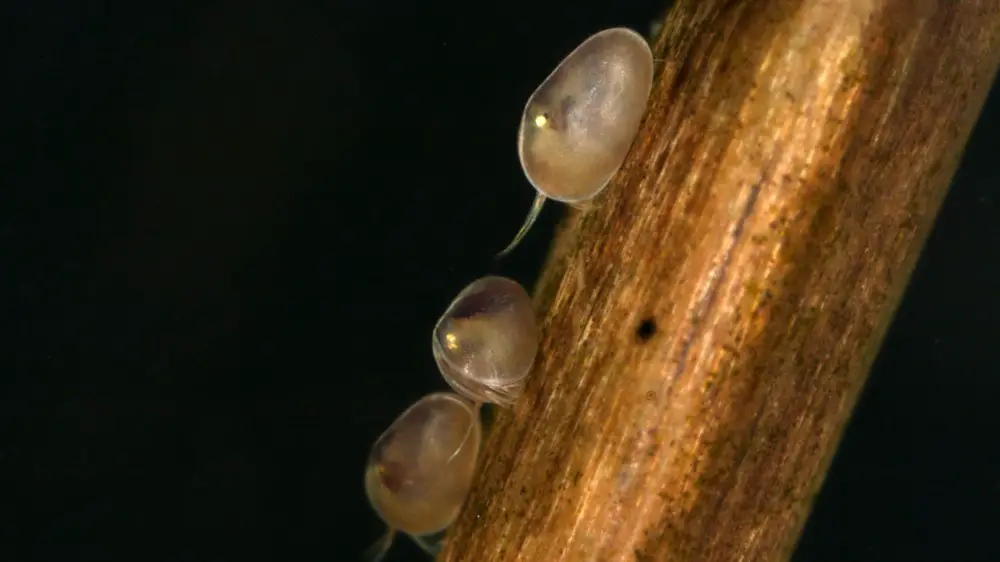
Seed Shrimp Ostracoda: The Drunken Bees of Your Tank
Seed Shrimp, also known as Ostracoda, are one of the smaller types of crustaceans that can inhabit your aquarium. Typically, they measure between 0.1 to 0.2 cm or 0.04 to 0.1 inches in size. As their name suggests, these creatures bear a striking resemblance to tiny seeds, hence the ‘Seed Shrimp’.
These little crustaceans are known for their unique movement. Much like the copepods, seed shrimp often move in a series of short leaps. However, when they venture into open water, their movement can seem a little erratic, almost like a bee that’s had a bit too much nectar. This peculiar behavior has earned them the nickname ‘drunken bees’.
Seed shrimp are not only interesting to watch, but they also play an essential role in your aquarium. They are avid consumers of organic material, feeding on detritus on the surfaces of glass, plants, and even inside the substrate. By doing this, they contribute to the cleanliness of your tank and the overall health of your aquatic ecosystem.
Despite their strange movement and seemingly drunken demeanor, seed shrimp are harmless to other inhabitants of your tank. They provide a captivating show with their peculiar movements and contribute to maintaining a balanced and healthy aquarium. Their presence is a sign of a thriving ecosystem and a testament to the diversity of life within your aquarium.

Freshwater Limpet: The Tiny Slow-Moving Snails
Freshwater limpets, specifically Acroloxus lacustris, are a type of small snail that you might encounter in your aquarium. Their size typically ranges from 0.1 to 0.8 cm or 0.04 to 0.3 inches. Freshwater limpets are slow-moving creatures, and due to their small size, it may be challenging to identify them as snails at first glance.
These tiny snails have an oval, flat shell that makes them resemble a small coin or seed. They move very slowly, inching along the surfaces of your aquarium, and can often be seen on the glass, plants, or decorations in your tank. Despite their small size, they can be quite fascinating to observe.
Freshwater limpets are harmless and can’t cause significant damage to your plants. However, because they are so small, it’s nearly impossible to find and remove their eggs and baby snails. This means that once you have freshwater limpets in your aquarium, they’re likely to be a permanent part of your aquatic community.
Despite their slow pace and tiny size, freshwater limpets play an essential role in your aquarium. They help maintain the balance of the ecosystem by consuming algae and other small particles of organic material. Their presence is a testament to the diverse life forms that can thrive in a well-maintained aquarium.
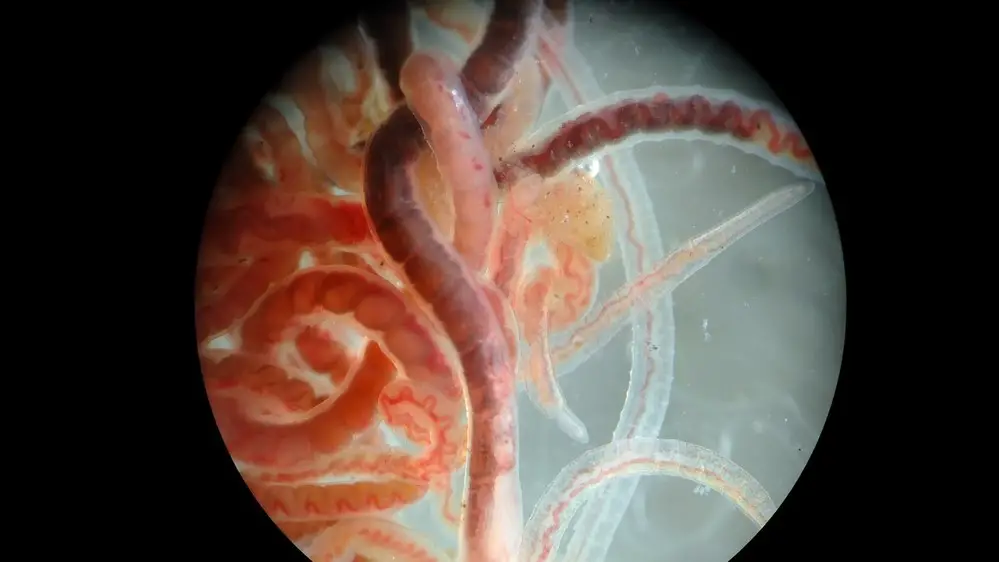
Tubifex
Tubifex are a type of worm that can inhabit your aquarium substrate. These creatures typically measure between 2 to 5 cm or 3/4 to 2 inches in length. They’re known for their distinctive red color, which can make them easy to spot against the darker substrate in your tank.
These worms have a fascinating behavior. When undisturbed, they live inside the substrate, often gathering pieces of sand or gravel around their bodies to form a tube-like structure. The head of the worm sticks out of the substrate, giving the appearance of red hairgrass. If disturbed, however, they will ball up, adding another layer of intrigue to their behavior.
Tubifex are often used as a form of live fish food due to their high protein content. However, they also serve another purpose in your aquarium. If there’s a significant population of these worms, it could indicate that the substrate is too dirty. Hence, their presence can serve as a useful indicator of when it might be a good idea to clean your tank.
due to their high protein content. However, they also serve another purpose in your aquarium. If there’s a significant population of these worms, it could indicate that the substrate is too dirty. Hence, their presence can serve as a useful indicator of when it might be a good idea to clean your tank.
While they are typically harmless, a large number of Tubifex could indicate an imbalance in your aquarium. Overfeeding or insufficient cleaning of the tank can lead to an overpopulation. However, a few Tubifex in the substrate shouldn’t be a cause for concern. They add to the diversity and complexity of life in your aquarium, providing a fascinating spectacle as they go about their unique way of life.
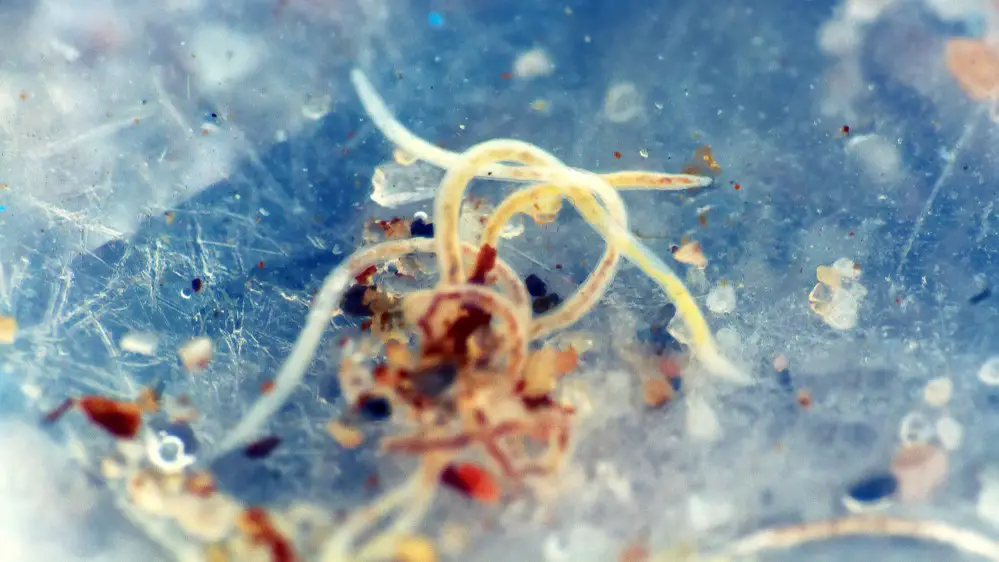
Nematodes: The Wriggling Roundworms
Nematodes, often referred to as roundworms, are another type of creature you might find in your aquarium. These small, thin, white or transparent worms typically measure between 0.1 to 0.3 cm, or up to 0.1 inches in length.
These free-living worms are known for their distinctive wave-like movement. When they move, they form an ‘S’ shape, wriggling briskly through the water or substrate. They might appear from the substrate or even from the filter when you turn it on, providing an interesting spectacle for those who appreciate the diverse range of life in an aquarium.
While nematodes are generally harmless, they do serve as an important indicator of the health of your aquarium. A large number of nematodes could suggest that you’re overfeeding your fish, or that you’re not keeping the tank clean enough. They feed on debris, decaying plant matter, and other organic material in the water, so a high nematode population could indicate an abundance of such material.
Despite their tiny size, nematodes play a significant role in the aquatic ecosystem. They help to break down organic material and contribute to nutrient cycling in the tank. Observing these wriggling roundworms in your aquarium can be a fascinating insight into the complexity of aquatic life. However, always remember that a balance in their population is essential for a healthy and thriving aquarium.

Planaria: The Regenerating Flatworms
Planaria, commonly known as flatworms, are a unique and fascinating addition to the ecosystem of your aquarium. Measuring between 0.3 to 1 cm, or 0.1 to 3/8 inches, these non-parasitic flatworms have a distinctive appearance that sets them apart from other aquarium creatures.
These flatworms have the unique capability to regenerate. If a planarian is split into pieces, each piece can grow into a new worm. This feature makes them incredibly resilient and a subject of interest for many aquarium enthusiasts.
Planaria are typically found in a variety of colours, including transparent, white, brown, and red. They move around on surfaces, even under the water surface, and are most active during the night. When disturbed, they will retract themselves, becoming shorter and wider, and then drop down to the bottom of the tank.
Despite their intriguing characteristics, it’s worth noting that planaria might not always be a welcome addition to your aquarium. They can bother small shrimp and snails, and might eat fish or snail eggs. They’re also known to eat small live creatures if they can catch them, as well as shrimp pellets, pieces of meat, and dead fish or shrimp..
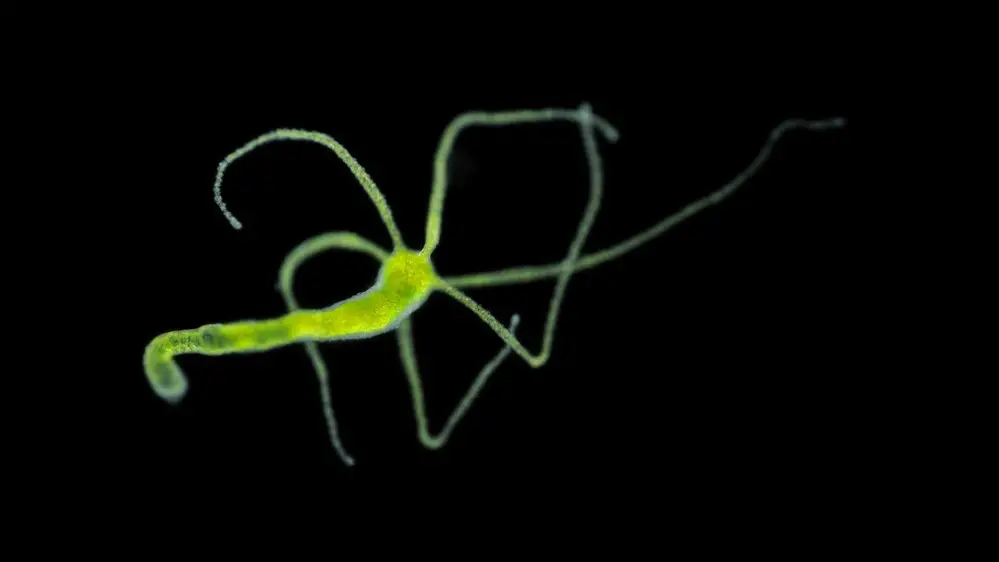
Hydra: The Beautiful Yet Annoying
Hydra are a unique category of creatures that you might encounter in your aquarium. With a size range from 0.3 to 1.5 cm, or 0.1 to 1/2 inches, they might not be the largest inhabitants of your tank, but they certainly make their presence known.
These creatures are interesting to watch due to their distinctive lifestyle. Hydra spend their lives attached to surfaces such as plants, glass, filters, and decorations. Although they’re capable of moving, they generally don’t feel the need to do so. When disturbed, they have the ability to retract their tentacles and body into small buds.
Hydra are known for their ability to catch small creatures, like copepods and Daphnia, with their tentacles which can sting and immobilize their prey. This makes it easier for them to pull the prey into their mouth opening. This feature, while fascinating, can be a nuisance in an aquarium setting, particularly if there are newborn fish or shrimp fry present, as they can be in danger from the Hydra.
While adult fish, shrimp, or snails are generally not threatened by Hydra (though they might experience some irritation if they touch the Hydra), it’s important to maintain a balance in their population. Their presence in the tank can be an indication of an abundance of small creatures which they feed on, signalling an imbalance in the aquarium ecosystem.
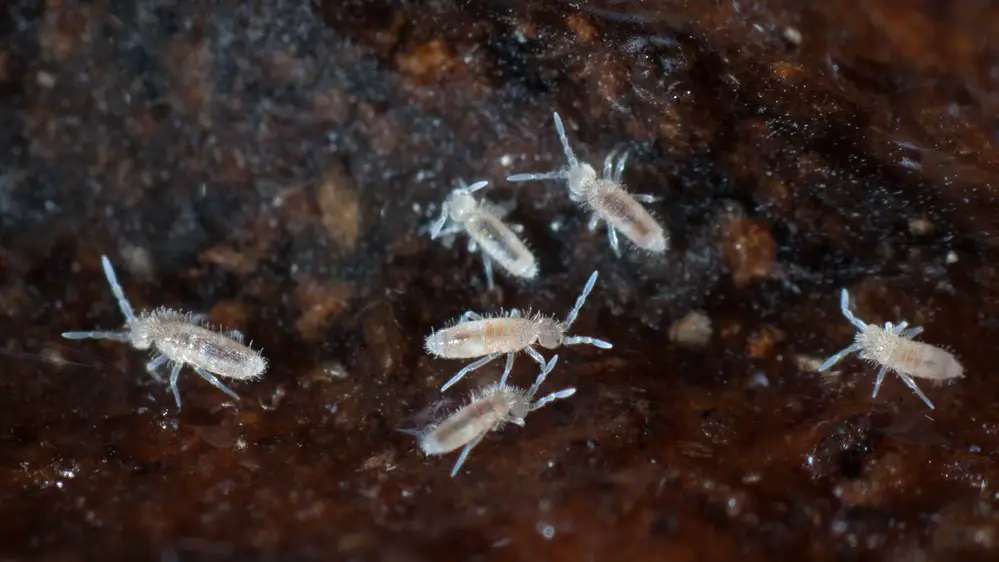
Springtails: The Jumping Hexapods
Springtails, also known by their scientific name, Collembola, are fascinating hexapods that may occasionally make their way into your aquarium. They typically range in size from 0.1 to 0.3 cm, or 0.04 to 0.1 inches. Although you’re more likely to find them in soil or leaf litter, they can sometimes appear on floating aquarium plants.
What makes springtails unique, and the reason for their name, is their ability to “spring” to safety when disturbed. They have a structure called a “furcula” that’s normally bent under their body. When they sense danger, they release this furcula, which propels them surprisingly far, often several centimeters. This jumping ability is a distinctive feature of springtails and one of the reasons they are so intriguing.
In addition to their interesting behavior, springtails also serve a functional role in some aquariums. They are used as live food for certain types of fish that eat from the surface, like small Betta species and labyrinth fishes. This makes them not only interesting to watch, but also beneficial in maintaining a balanced ecosystem within the tank.
Despite their occasional appearance in aquariums, springtails pose no threat to the other inhabitants. They are harmless creatures that add a touch of diversity and excitement to your aquarium. Their presence is a testament to the rich variety of life that an aquarium can support, making each glance into the water a potential discovery.
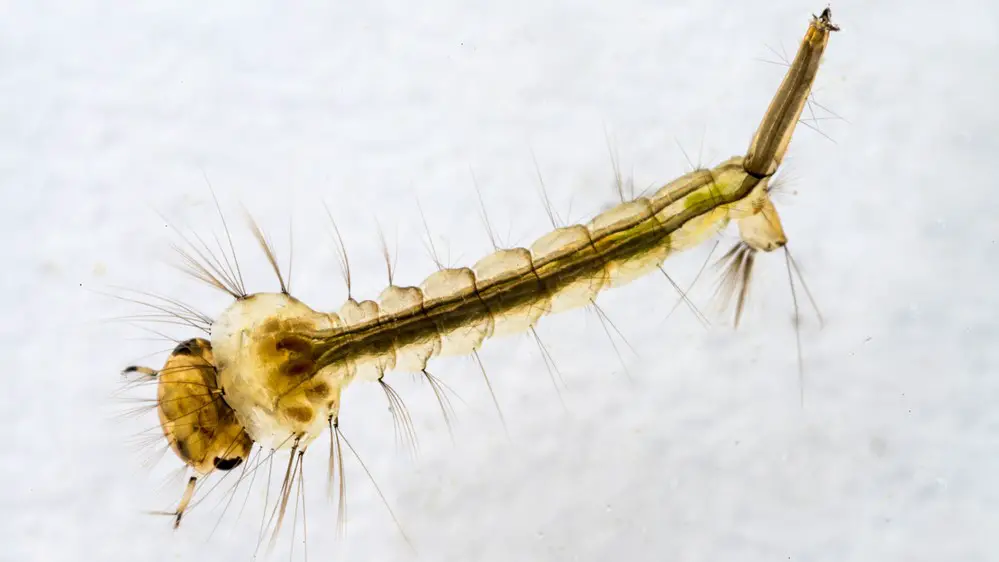
Mosquito Larvae: Unwanted Guests in Your Tank
Mosquito larvae are an unfortunate and unwanted guest that may occasionally find their way into your aquarium. Their presence is often unexpected, as mosquitoes lay their eggs in stagnant water, which may include the calm surface of your tank.
Mosquito larvae are easily identifiable. They have an elongated, segmented body and a head that contains a mouth brush used for feeding. They spend much of their time near the water’s surface, where they breathe through a tube located at the end of their body. They are also known for their distinctive “wriggling” movement, which can be seen as they move up and down in the water.
Although they may seem like a harmless addition to your tank, it’s important to remember that mosquito larvae eventually turn into adult mosquitoes. Mosquitoes are not only a nuisance due to their biting habits, but they also pose a health risk as they are known carriers of various diseases. Therefore, it’s advisable to remove mosquito larvae from your tank as soon as you spot them.
There are several ways to remove mosquito larvae from your aquarium. One method is to simply scoop them out using a net. Alternatively, some fish species, such as guppies and bettas, are known to eat mosquito larvae and can help control their population.
Preventing mosquitoes from laying eggs in your tank in the first place is the best way to avoid dealing with larvae. This can be achieved by maintaining a clean tank and avoiding stagnant water, which mosquitoes are attracted to for egg-laying. Regular maintenance and water movement from filters or water features can also deter mosquitoes from viewing your aquarium as an ideal breeding ground.
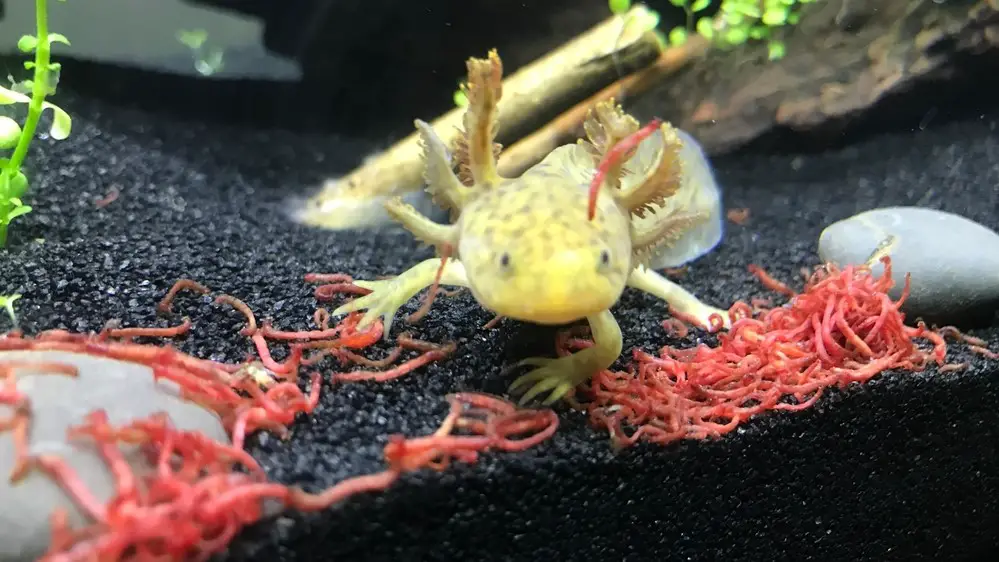
Bloodworms: The Mysterious Creatures
Bloodworms are a type of aquatic larvae belonging to the Chironomid family. They are not actually worms, but midge larvae, named for their bright red color which is due to the presence of hemoglobin in their bodies. This allows them to live in low-oxygen environments where other creatures might not survive.
These mysterious creatures are quite fascinating. Their elongated bodies, which can be segmented, are typically a couple of inches long, and they have a distinctive set of jaws that are not typically found in organisms of their kind. Bloodworms are usually found at the bottom of freshwater bodies, where they burrow in the sediment.
In an aquarium setting, you might not encounter these creatures unless you introduce them yourself. They are a common food source for many types of fish and are often sold in live, frozen, or freeze-dried form in pet stores for this purpose. They are highly nutritious and a favorite among many fish species, providing a rich source of protein.
It is important to note that while bloodworms are generally safe for most fish, they can be harmful or even deadly to some species if fed excessively. This is due to their hard outer shell which can cause blockages in the digestive system of smaller fish or those with a slow metabolism. Always research your specific species’ dietary needs before introducing a new food source.
In the rare case you do find bloodworms in your tank without intentionally introducing them, this could be an indication of poor water quality or overfeeding, as these conditions can attract the midges that lay the eggs which become bloodworms. Regular cleaning and maintenance of your tank should prevent this from happening.

Leeches in Aquariums: The Slithering Suckers
Leeches (Order Hirudinea) are a group of animals that can sometimes be found in aquariums. They vary significantly in size, with some species being as small as 1 cm (0.4 inches) and others growing up to a whopping 10 cm (4 inches) in length.
These creatures are notable for their elongated bodies that are usually brown or black. However, there are many different species of leeches, and they can come in a variety of colors and patterns. Leeches are equipped with suckers on both ends of their body, which they use for movement and feeding.
In the wild, leeches are known to feed on the blood of other animals. However, in an aquarium setting, they may feed on leftover food or detritus in the tank.

Rhabdocoela: The Misidentified Flatworms
Rhabdocoela, commonly mistaken for their notorious cousins, the planaria, are a type of flatworm that are often found in aquariums. These unsegmented, soft-bodied invertebrates exhibit a variety of shapes and sizes, with most being rather small, making them somewhat challenging to identify.
Unlike planaria, Rhabdocoela are generally harmless to your tank’s inhabitants. However, their presence could indicate an imbalance in your aquarium’s ecosystem, particularly overfeeding or overstocking. This is because these flatworms feed on detritus and organic matter that accumulate due to excessive food or a large number of fish.
Their resemblance to planaria often leads to misidentification, which can cause unnecessary panic among aquarists. The key to differentiating them lies in their behavior and movement. Planaria are known to glide smoothly across surfaces, whereas Rhabdocoela exhibit a more erratic, wiggling motion.
Understanding the different types of organisms in your tank, like the Rhabdocoela, helps ensure a healthy and thriving environment for your aquatic pets. Despite their less than glamorous reputation, these flatworms play a role in the ecosystem of your tank by helping to break down and recycle organic matter.
Remember, a sudden increase in their population could be a sign of overfeeding or overstocking. Always maintain a balanced feeding routine and be mindful of the number of inhabitants in your aquarium to keep these little flatworms, and other creatures, in check.
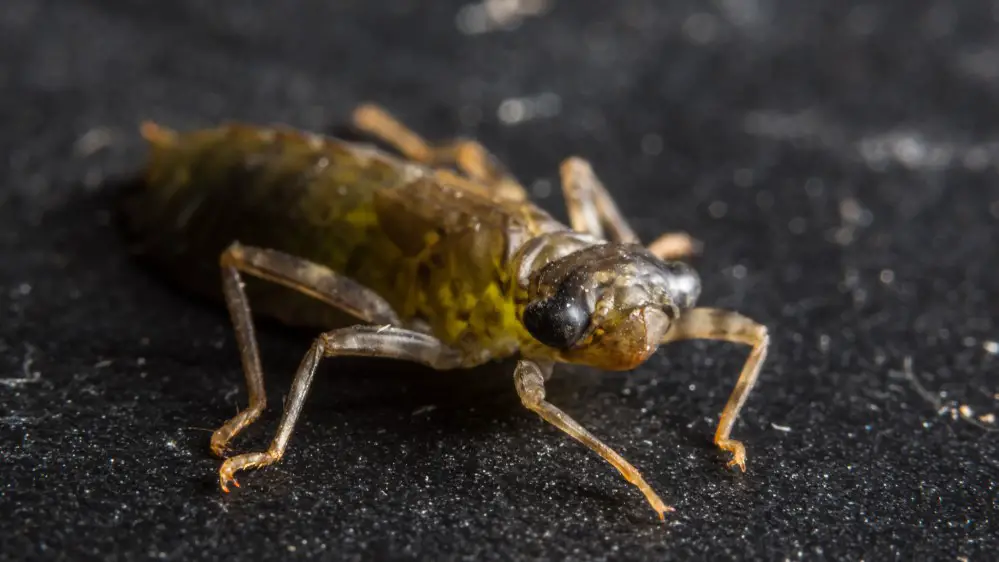
Dragonfly Larvae: Fierce Predators of the Aquatic Realm
Dragonfly larvae, also known as nymphs, are intriguing creatures that inhabit the underwater world before they transform into the beautiful and agile insects we commonly recognize. These larvae are formidable predators and play a vital role in the aquatic ecosystem.
Dragonfly larvae have a distinct appearance with elongated bodies and a hinged jaw that extends forward to capture prey. They possess well-developed legs that allow them to move with precision and speed in the water. Their coloration varies depending on the species, but they often blend in with their surroundings, making them excellent ambush predators.
These voracious predators feed on a diverse range of aquatic organisms, including mosquito larvae, small fish, tadpoles, and even other invertebrates. Their feeding behavior helps control the population of potential pests and contributes to the overall balance of the ecosystem.
In aquariums, dragonfly larvae can occasionally find their way into the water, especially if there are open windows or nearby bodies of water. While they may appear fascinating to observe, it is important to note that they are not suitable long-term residents for most aquarium setups. Dragonfly larvae have a predatory nature and can pose a threat to smaller fish, shrimp, and other tank inhabitants.
If you discover dragonfly larvae in your aquarium, it is recommended to remove them promptly and return them to their natural habitat. Ensuring proper tank security, such as using screens or mesh coverings, can help prevent their entry into the aquarium in the first place.
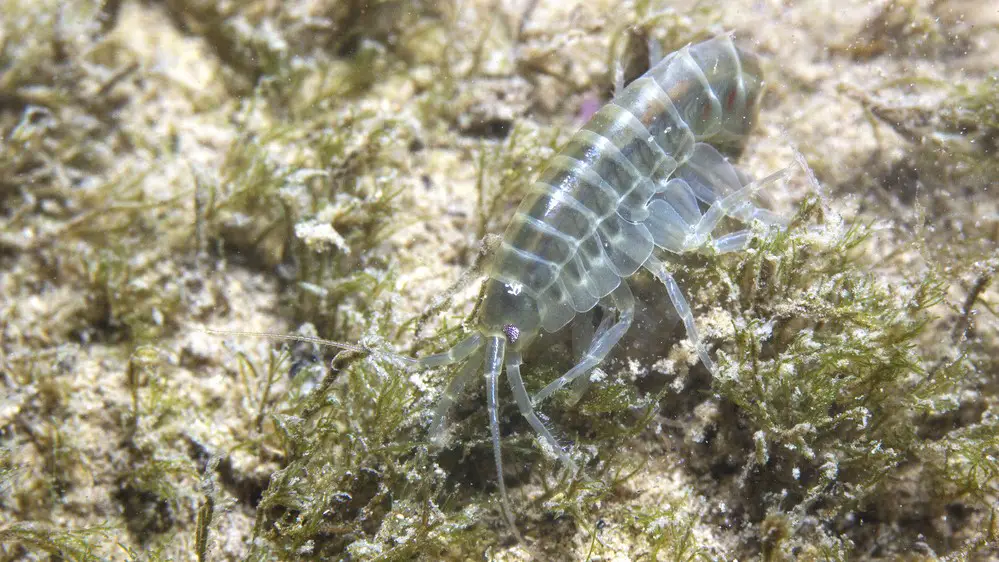
Scuds: Tiny Shrimp-like Crustaceans
Scuds, also known as freshwater amphipods, are small crustaceans that are commonly found in freshwater environments, including aquariums. These fascinating creatures belong to the order Amphipoda and are closely related to shrimp and other crustaceans.
Scuds have a distinct body shape, resembling a small shrimp. They typically have a curved body, which allows them to move in a unique hopping motion using their powerful legs. Their size can vary, but they are generally around 1 to 2 centimeters in length.
One of the remarkable features of scuds is their ability to adapt to a variety of aquatic habitats. They can be found in various freshwater environments, including rivers, streams, ponds, and even in aquariums. Scuds are often introduced into aquariums unintentionally, hitchhiking on plants, rocks, or other aquarium decorations.
In the aquarium, scuds serve as valuable members of the ecosystem. They are detritivores, meaning they feed on decaying organic matter, algae, and other microscopic organisms. By consuming these organic materials, scuds help to maintain water quality and prevent the buildup of debris in the tank.
From an aquarist’s perspective, scuds can be interesting to observe and serve as a natural food source for many fish and invertebrates. They are often utilized as live food for small fish species, such as bettas or killifish. Additionally, some hobbyists appreciate scuds as part of a natural, self-sustaining aquarium ecosystem.
However, it is important to note that scud populations can multiply rapidly under certain conditions. In heavily planted aquariums with ample food sources, their numbers can increase significantly, potentially leading to an imbalance in the ecosystem. If scud populations become excessive, they may compete with other tank inhabitants for resources or become a nuisance.
To manage scud populations, various strategies can be employed. This may include adjusting feeding practices, reducing the availability of excess food, or introducing natural predators that feed on scuds, such as certain species of fish or shrimp.
Conclusion
In my experience as an aquarist, I’ve come to realize that many of these tiny organisms can coexist peacefully in a well-balanced aquarium. My guiding principle is simple: if they pose no threat to the other inhabitants, they are more than welcome to stay. They add a fascinating layer of complexity to the micro-ecosystem that thrives within our tanks, contributing to the overall health and stability of the aquarium.
However, there are instances when some creatures can become troublesome, preying on other tank mates, or compromising the health of fish and shrimp. In such cases, it becomes necessary to intervene and take necessary actions to restore the balance. It’s important to understand that this post isn’t about getting rid of pests, but rather about identifying them and understanding their roles in your tank.
As aquarists, our ultimate goal should be to maintain a healthy and balanced environment for all our aquatic pets. Every decision we make, including how we handle these bugs, should be guided by this goal. So, while it’s fascinating to watch these creatures go about their lives, it’s equally crucial to monitor their population and impact on your tank.
I have to also state that is not a definitive list because I am not a zoologist, there will be literally thousands of different types of springtails as an example that wont look like the picture I have show, What I have tried to do is find the most common species of the examples above to help you hopefully identify them.
In the end, how you handle these bugs is your choice. After all, it’s your little underwater world, and you’re the steward of it.
Happy Bug Keeping!
FAQs:
Q: Are all these bugs harmful to my fish? A: No, most of these bugs are harmless and can even contribute to the health of your aquarium. However, some like the Hydra can pose a threat to newborn fish and shrimp fry.
Q: I see a lot of Nematodes in my tank. Should I be worried? A: A high number of Nematodes might indicate overfeeding or inadequate tank cleanliness. These creatures are harmless but their overpopulation can be a sign of an imbalance in your tank.
Q: How can I control the number of bugs in my aquarium? A: Maintaining a clean tank and feeding your fish appropriately should keep the bug population in check. However, if you notice an overpopulation of a certain bug, you might need to take specific measures to control their numbers.
